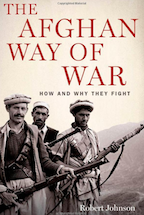
OEF owner's manual
After a decade of war in Afghanistan, there’s a new guidebook out on just who we’re fighting. It’s The Afghan Way of War by Robert Johnson, Oxford historian. It is his subtitle – How and Why They Fight – that should be required reading for the leaders of both the U.S. and U.K., as well as the grunts on Afghan soil. Battleland conducted an email exchange with Johnson about his work:
What’s the most important thing you learned in writing The Afghan Way of War?
The most significant discovery was the Afghan perspective, which was just as full of misconceptions and errors of judgment as their adversaries who occupied their lands. The greatest fallacy of all is the tendency to generalize about Afghans. In Afghanistan, ‘localism’ is all. It matters a great deal how power is distributed, that there is redress, equilibrium and accountability.
Afghans have often been attributed with the ability to defeat all invaders, but The Afghan Way of War illustrates that co-opting foreigners to serve local power interests could be far more important. It is also striking how frequently Afghan regular military forces underperformed in Afghanistan’s history, compared with irregular fighters. While habits of fighting styles emerged, pragmatism would always triumph, so settling scores might just as easily become settling of differences, if it served the purposes of local leaders.
Most surprising was the realization that foreign military interventions, far from fulfilling the rhetoric of nationalists claiming an affront to Islam and identity, actually created long term benefits for Afghanistan that were not apparent at the time.
What is the biggest misconception Westerners have about the Afghan way of war?
Very often Westerners assume that the past repeats itself in Afghanistan, or, at the very least, there are ‘obvious’ parallels in the Afghan way of war. Interestingly, policies were framed in 2001 precisely in order to avoid repeating the past, namely, a permanent military occupation. By seeking a cheaper alternative, it seems the Coalition may have in fact worsened the situation.

Oxford
Although it may have had a decisive effect, too little assistance was offered to Afghanistan between 2001 and 2006. A failure to consult local peoples, too much haste and eagerness to impose Western models alienated many who would otherwise have tolerated the Coalition forces.
Assumptions were then often made that Afghan ‘Taliban’ were ideologues aligned precisely to Al Qaeda, when many were in fact fighting for local interests. Understanding the more subtle and nuanced perspectives has greatly assisted International Security and Assistance Force (ISAF) units to come to terms with who has been fighting them and why.
Is there such a thing as the “$10 Taliban”? What share of the Taliban do you think they are?
Most fighters are drawn from local communities, although there is a significant levy from outside the country who have been used to stiffen, facilitate and lead groups of local fighters. A proportion of locals fight without any expectation of financial reward, although there has been an understanding that certain fighters have earned more than $10 a day, and commanders three times that amount.
For some years, this acted as a competitive salary compared with the rates of pay of uniformed police and Afghan Army ‘warriors’. Nevertheless, money is no guide to loyalty. A Pashtun proverb warns that you can hire an Afghan, but you can never buy him.
Who is now the enemy in Afghanistan?
This very much depends on one’s perspective. More than one ISAF commander has specified that the task of Western forces is to protect the Afghan people not only from insurgents but also predatory police and officials. Many Afghans in rural areas express the view that Pakistan is becoming a greater enemy than the foreigners or the corrupt elites of Kabul.
No foreigners or government workers who coerce Afghans are tolerated, and there is little faith or trust in outsiders generally, especially if they provide no protection. However, there are memories of how Pakistan has tried to interfere in Afghanistan before and the civil war of 1989-2001 is largely blamed on Islamabad.
For the West, its enemies too are shifting. Where once Al Qaeda loomed largest, now it is the Haqqani network and the insurgents of regional Command East who pose the greatest threats. One hopes that the enemies of good government – impatience and hubris – have now been slain.
Can Afghanistan build and sustain an army?
Building an army is often easier than sustaining one. The Western military plan is to gradually scale back the large Afghan National Security Forces as the security situation improves. This expectation is not settled in time, but is assumed to be after the Western transition in 2014-2015.
The Afghan government cannot sustain a large army and police service through its own revenues, and there is a risk that the Afghan army might precipitate some sort of seizure of power to secure its position in Afghan politics and prevent its contraction. Finding employment for these troops, police and Auxiliary police will be the key to avoiding a security crisis.
Do you think it makes sense for all international combat troops to get out of Afghanistan by 2015?
It makes perfect sense to carry out a staged withdrawal, and, contrary to some accounts, this was always envisaged. No one planned for a permanent occupation. What appears to be at stake, however, is the ability to ensure that the stabilization measures in the economy and governance can endure beyond the Western military withdrawal.
The recent National Intelligence Estimate may, if rumors are accurate, take a negative view of this, but ISAF officers remain upbeat. A premature or rapid withdrawal would almost certainly undo the precarious security situation in Regional Command East.
In one incident last year, ANSF abandoned their posts the moment they came under fire from insurgents, but elsewhere in the country they have been more resilient and have led their own independent operations against fighters. The picture is therefore mixed and is likely to remain so: some areas will probably remain under government jurisdiction, others may not.
What did the U.S., U.K. and their allies do right when they invaded Afghanistan following the 9/11 attacks?
Much has been made of the successful formula in 2001 in Afghanistan of Western air power with Special Operational Forces on the ground, seeking the consensus and support of willing local fighters, which was also a feature in Kosovo and Libya.
The restoration of Afghan sovereignty in 2001, the deployment of development assistance, to search for a local leader with broad based support and the development of local security forces were also measures which went a long way to win Afghan support. Above all, restoring the pride and dignity of Afghans, to enable them to secure and govern their own people and territory, was and is vital.
What did the U.S., U.K. and their allies do wrong when they invaded Afghanistan following the 9/11 attacks?
A number of errors were made after 2001 which has led some to believe that Westerners were the enemy, which in turn meant continuation of the war and the squandering of opportunities for funding, peace and development. In Afghan history, this realization is not unusual.
Yet after 2001 the most glaring problems were to design a legal and constitutional system that did not build consensus, that Western forces allowed themselves to be manipulated by factions, to be drawn into a military occupation without adequate ‘lines of operation’ in governance and economic assistance, and a failure to unify their efforts or align them with Afghans.
The greatest dereliction of duty though has not been by soldiers, but by political leaders, ambassadors and policy advisors who failed to design a diplomatic solution. While the soldiers did their best to secure, or build, or understand the local peoples needs, their political masters either ignored Afghanistan in favor of Iraq, or failed to engage in regional or local dialogues.
Some of these political figures have sheltered behind the ranks of the soldiers, the wounded and the dead, but history has a way of judging such betrayal and incompetence with devastating precision.


